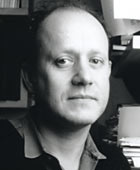Thomas Jessell
The annual John M. Prather Lectures in Biology will showcase the work of Thomas Jessell, a Columbia University Medical Center neuroscientist who has spent many years untangling no less a problem than how behavior is encoded in the vertebrate nervous system. In what he calls a “bottom-up” strategy, Jessell and his colleagues are attempting to understand the simplest relay circuits in the spinal cord from their earliest development to how the neurons become different and how they connect with target cells.
Jessell is professor of biochemistry and molecular biophysics at Columbia and codirector of the newly established Kavli Institute for Brain Science there. He is also a Howard Hughes Medical Institute Investigator.
Trained in England, Jessell did research in the Harvard laboratory of Gerald D. Fischbach (now dean of the faculty of medicine at Columbia) from 1981 to 1985. There he studied the early development of neurons in the spinal cord. After Jessell moved to Columbia in 1985, the Harvard work culminated in the discovery of neuregulins, factors that regulate motor neurons’ effects on their synapses with other nerves.
Jessell’s main research interests at Columbia are in defining mechanisms that specify the “identity” of neurons, coordinate the pattern of the nerve cells’ extensions (axons), and determine their selective synaptic connections to target cells.
ES cell derived motor neurons (green) grafted into embryonic spinal cord
extend axons into the periphy and innervate muscle targets. Major nerve
pathways shown in red. (Image courtesy of Jessel Lab)
The first of his Prather talks is entitled “Gradients, Transcriptional Codes, and Neuronal Diversity.” The talk will cover experiments aimed at understanding the logic of diversifying neurons to build up the array of hundreds or thousands of different types of neurons that exist in the central nervous system.
The next day, Jessell will speak on “A Deterministic View of Neural Circuit Assembly in the Developing Brain.” The question here, he says, is “once the neurons have individual identities, what is necessary to hook them up to form a functional circuit?”
Jessell s third and final talk will be part of an inaugural symposium for the Harvard Stem Cell Institute, designed to explore the complex biological and therapeutic aspects of stem cells and to serve as an educational resource for the Harvard community. The lecture is on “Directing Stem Cell Differentiation: Insights from Neural Development.” In Jessell’s lab, researchers are introducing genes into embryonic stem cells, or knocking genes out, to help them understand how such a stem cell can become, for example, a motor neuron.
If Jessell and his colleagues can tease out the gene expression patterns that contribute to normal neuron development, there could be vital implications for neurodegenerative disorders and spinal cord injuries. The research “leads to questions in neurodegenerative disorders such as, can you prevent the neuron from dying? Can you replace the missing neurons from (neural) precursors in adults, or generate new neurons?” says Jessell.
“In the last 10 years,” he says, summing up the movement in his field, “the advances in understanding the molecular biology of circuit formation have moved from an abstract venture into something that will have clinical impact.”
Sensory nerve terminals (red) contacting a
motor neuron (green) in the developing spinal
cord. (Image courtesy of Jessel Lab)
View poster for this event (pdf)
Photo of Dr. Jessel by Chris Denney


